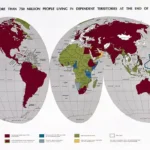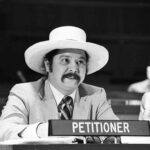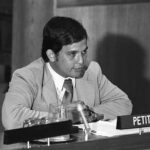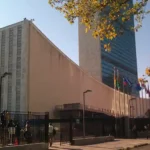United Nations Role in Guam’s Decolonization
Table of Contents
Share This
UN Charter for self-determination of all peoples
After World War II in 1945 leaders from 51 countries met in San Francisco, California to form the United Nations, committing to maintain international peace and security, develop friendly relations among nations and promote social progress, better living standards and human rights.
Within the UN Charter is a set of principles that include respect for self-determinations of all peoples. At the time the UN Charter was created 750 million people – nearly a third of the world’s population – lived in territories that were non-self-governing, dependent on larger, colonial powers.
Since then more than 80 former colonies have gained their independence. Today, fewer than 2 million people live in colonies. There are 17 non-self-governing territories in the world today. Guam is one of them.
The UN monitors progress toward self-determination of these remaining territories. In 1960, the UN General Assembly adopted a Declaration on Decolonization, stating that all people have a right to self-determination. It proclaimed that colonialism should be brought to a speedy and unconditional end.
In 1962, the General Assembly established the Special Committee on Decolonization to monitor implementation of the Declaration and to make recommendations on its application. In 1990, the General Assembly proclaimed 1990-2000 as the International Decade for the Eradication of Colonialism and adopted a Plan of Action. In 2001, the Second International Decade for the Eradication of Colonialism was proclaimed. In 2011, the General Assembly proclaimed 2011-2020 as the Third International Decade for the Eradication of Colonialism.
Committee of 24
According to information on the UN website the Special Committee on the Situation with Regard to the Implementation of the Declaration on the Granting of Independence to Colonial Countries and Peoples, known as the Special Committee on Decolonization or C-24, is mandated to promote the full implementation of the General Assembly’s 1960 Declaration on decolonization.
To that end, on a case-by-case basis and in accordance with the relevant UN resolutions on decolonization, the Special Committee:
- Keeps the political, economic and social situation in Non-Self-Governing Territories under review
- Provides information on territorial developments
- Facilitates Territory-specific decolonization processes underway
- Offers advice on the decolonization options under the Declaration
- Conducts annual regional seminars for face-to-face discussion with territorial and civil society representatives as well as experts
- Dispatches fact-finding and advisory visiting missions to Territories
The UN has also set three acceptable political status outcomes to achieve self-determination: Statehood, Free Association and Independence.
CHamorus speak up
Every year since 1946 the US submits a report to the UN Committee on progress being made toward CHamoru/Chamorro self-determination. Dr. Robert Underwood is a firm believer that if someone is talking about you, you should be at the table and speak for yourself. So in 1982 he and two others went to New York to provide their own report about Guam.
The idea for CHamorus to appeal to the UN directly came about after the second Constitutional Convention (ConCon) held on Guam in 1977. This ConCon was convened on 1 July 1977 to create a constitution for Guam that would redefine the island’s relationship with the US rather than merely modifying the existing relationship.
The ConCon met periodically through 31 October 1977 and drafted a constitution to govern Guam as an unincorporated territory of the United States. The proposed constitution incorporated social, economic, cultural, political, and administrative reforms. This departed significantly from the US-written and imposed Organic Act of Guam of 1950.
The US invited UN representatives to Guam to witness the vote. This invitation, the first of its kind, alerted Underwood and others that ratifying the constitution could be seen as achieving decolonization for Guam.
Para Pada was created to advocate that the Constitution not be passed. After much heated debate the Constitution was defeated. As a result, the 15th Guam Legislature commissioned the first in-depth assessment of all possible status options for Guam in 1979. The assessment included integration with the Northern Mariana Islands and annexation to the state of Hawai’i as a county.
In 1982, after some community fundraising and the formal organization of a new group called OPI-R (Organization of People for Indigenous Rights) representatives Underwood, Chris Perez Howard and Ron Teehan went to the UN and petitioned on Guam’s behalf. At the time some believed that to speak out about Guam’s unsatisfactory political status was un-American. Some even believed it to be illegal and possibly traitorous. There was concern that Underwood may be arrested for speaking out for the CHamoru people but that didn’t happen.
Underwood said speaking up is important because it puts more pressure on the US and the UN and gives voice to the indigenous people of Guam. Since then dozens of others have followed suit.
Political leaders of Guam, too, have invited the UN to Guam to observe and advise the CHamoru people on how to proceed. In August 2017, Gov. Eddie Calvo approved a letter addressed to the UN requesting a visiting mission, before a Fourth Committee meeting in October 2017. No response has been received to date.
Guam's Testimonies before the United Nations
General Assembly
1982 August – Robert A. Underwood.
2006 October – Published in Hita Guåhan.
- “The Gravity of Militarization,” by Julian Aguon.
- “Breaking the Cycle of Colonialism,” by Fanai Castro.
- “Chamoru Self-Determination På’go,” by Hope Cristobal.
- “The Sacred Center,” by Tiffany Naputi Lacsasdo.
- “The Legacies of War,” by Victoria Leon Guerrero.
- “The Poisons of Powerlessness,” by Sabina Flores Perez.
2008 October – Published in Hita Guåhan.
- “Storm of US Militarization,” by Julian Aguon.
- “Protect: land, water, air, spirituality, language, culture & human rights,” by Victoria Leon Guerrero.
- “From the Soul and Spirit of Our Ancestors,” by Vicente Cabrera Pangelinan and read by Ailene Quan.
- “Contamination of the Pacific,” by Craig Santos Perez.
- “Transforming Our Island,” by Sabina Flores Perez.
- “A long History of Exclusion,” by Michael Anthony Tuncap.
Pacific Regional Seminars
2006 – Cristobal, Hope Alvarez. Yanuca, Fiji. Download
2008 – Cristobal, Hope Alvarez. Bandung, Indonesia. Download
2010 – Cristobal, Hope Alvarez. Nouméa, New Caledonia. Download
2012 – Alvarez, Edward. Quito, Ecuador. Download
- Natividad, LisaLinda. Download
2014 – Alvarez, Edward. Denarau, Nadi, Fiji. Download
2016 – Alvarez, Edward. Managua, Nicaragua. Download
- Bevacqua, Michael Lujan. Download
Caribbean Regional Seminars
2011 – Alvarez, Edward. Kingstown, Saint Vincent and the Grenadines. Download
- McNinch-Su, Ronald. Download
2013 – Alvarez, Edward. Quito, Ecuador. Download
- Bevacqua, Michael Lujan. Download
2015 – Alvarez, Edward. Managua, Nicaragua. Download
- Bevacqua, Michael Lujan. Download
2017 – Blas, Amanda. Kingstown, Saint Vicente and the Grenadines. Download
- Bevacqua, Michael Lujan. Download
Hita Guåhan
These booklets are a collection of testimonies given to the United Nations Special Political and Decolonization Committee (Fourth Committee) on 4 October 2006 and 7 October 2008. These testimonies were given by CHamoru members of human rights organizations and local leaders before the Fourth Committee on behalf of the people of Guam on issues concerning the military build-up and the right to self-determination.
Videos
Let Freedom Ring. The Chamorro Search for Sovereignty, 1997. Courtesy of the Cabazon Band Of Mission Indians.





